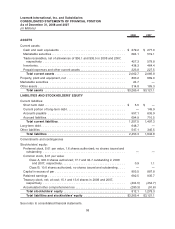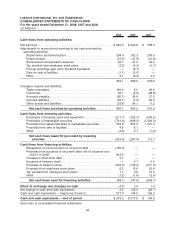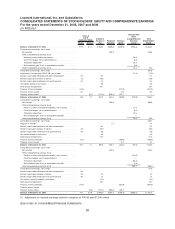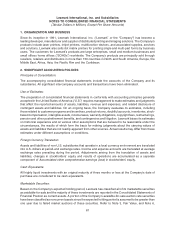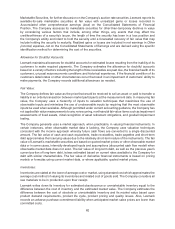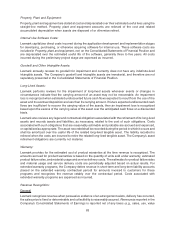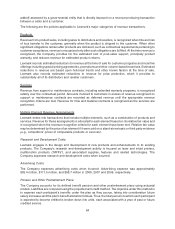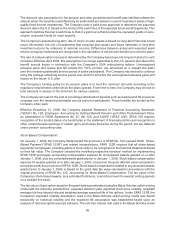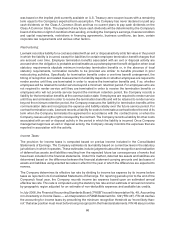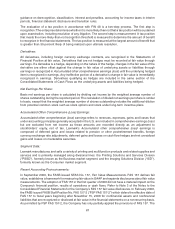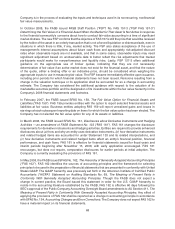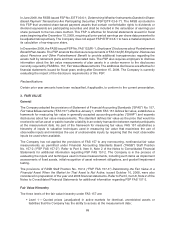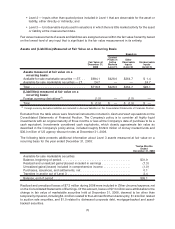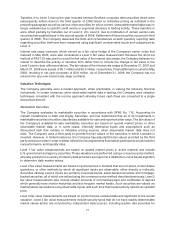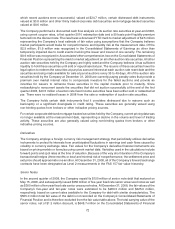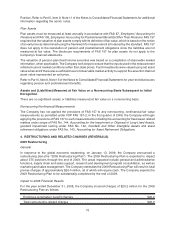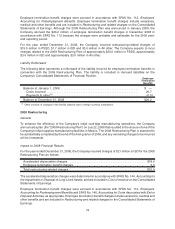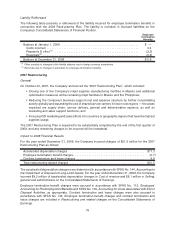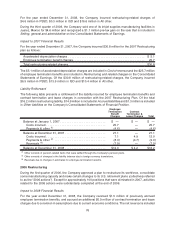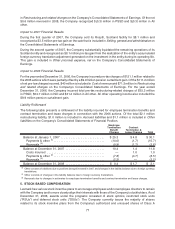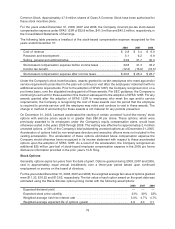Lexmark 2008 Annual Report Download - page 74
Download and view the complete annual report
Please find page 74 of the 2008 Lexmark annual report below. You can navigate through the pages in the report by either clicking on the pages listed below, or by using the keyword search tool below to find specific information within the annual report.Company is in the process of evaluating the inputs and techniques used in its nonrecurring, nonfinancial
fair value measurements.
In October 2008, the FASB issued FASB Staff Position (“FSP”) No. FAS 157-3 (“FSP FAS 157-3”)
Determining the Fair Value of a Financial Asset When the Market for That Asset Is Not Active in response
to the financial community’s concerns about how to conduct fair value accounting in a time of significant
market distress. The new FSP confirms that the objective of FAS 157 is still the price that would be received
by the holder of the asset in an orderly transaction that is not a forced liquidation or distressed sale, even in
situations in which there is little, if any, market activity. The FSP also states acceptance of the use of
management’s internal assumptions about future cash flows and appropriately risk-adjusted discount
rates when observable inputs are not available, and that in some cases, observable inputs may need
significant adjustment based on unobservable data to better reflect the risk adjustments that market
participants would make for nonperformance and liquidity risks. Lastly, FSP 157-3 offers additional
guidance on the appropriate use of broker quotes, indicating that they are not necessarily
determinative of fair value if an active market does not exist for the financial asset, and that the nature
of the quote, either a binding offer or an indicative price, should be considered when weighing the
appropriate inputs to use in measuring fair value. The FSP became immediately effective upon issuance,
including prior periods for which financial statements have not been issued. Revisions resulting from a
change in the valuation technique or its application shall be accounted for as a change in accounting
estimate. The Company has considered the additional guidance with respect to the valuation of its
marketable securities portfolio and the designation of its investments within the fair value hierarchy in the
Company’s 2008 financial statements and footnotes.
In February 2007, the FASB issued SFAS No. 159, The Fair Value Option for Financial Assets and
Liabilities (“FAS 159”). FAS 159 provides entities with the option to report selected financial assets and
liabilities at fair value. Business entities adopting FAS 159 will report unrealized gains and losses in
earnings at each subsequent reporting date on items for which the fair value option has been elected. The
Company has not elected the fair value option for any of its assets or liabilities.
In March 2008, the FASB issued SFAS No. 161, Disclosures about Derivative Instruments and Hedging
Activities — an amendment of FASB Statement No. 133 (“FAS 161”). FAS 161 changes the disclosure
requirements for derivative instruments and hedging activities. Entities are required to provide enhanced
disclosures about (a) how and why an entity uses derivative instruments, (b) how derivative instruments
and related hedged items are accounted for under Statement 133 and its related interpretations, and
(c) how derivative instruments and related hedged items affect an entity’s financial position, financial
performance, and cash flows. FAS 161 is effective for financial statements issued for fiscal years and
interim periods beginning after November 15, 2008, with early application encouraged. FAS 161
encourages, but does not require, comparative disclosures for earlier periods at initial adoption. The
Company is currently evaluating the provisions of FAS 161.
In May 2008, the FASB issued SFAS No. 162, The Hierarchy of Generally Accepted Accounting Principles
(“FAS 162”). FAS 162 identifies the sources of accounting principles and the framework for selecting
principles to be used in the preparation of financial statements that are presented in conformity with United
States GAAP. The GAAP hierarchy was previously set forth in the American Institute of Certified Public
Accountants (“AICPA”) Statement on Auditing Standards No. 69, The Meaning of Present Fairly in
Conformity With Generally Accepted Accounting Principles. Though the FASB does not expect a
change in current practice, the Board issued this statement in order for the U.S. GAAP hierarchy to
reside in the accounting literature established by the FASB. FAS 162 is effective 60 days following the
SEC’s approval of the Public Company Accounting Oversight Board amendments to AU Section 411, The
Meaning of Present Fairly in Conformity With Generally Accepted Accounting Principles. Any effect of
applying the provisions of FAS 162 shall be reported as a change in accounting principle in accordance
with SFAS No. 154, Accounting Changes and Error Corrections. The Company does not expect FAS 162 to
have a material impact on its financial statements.
68


